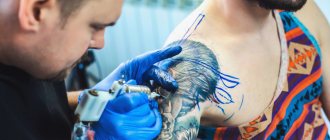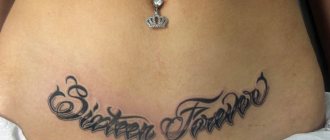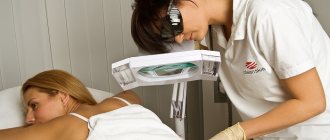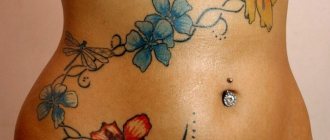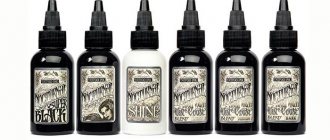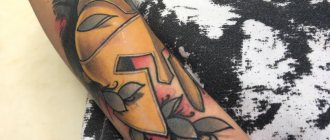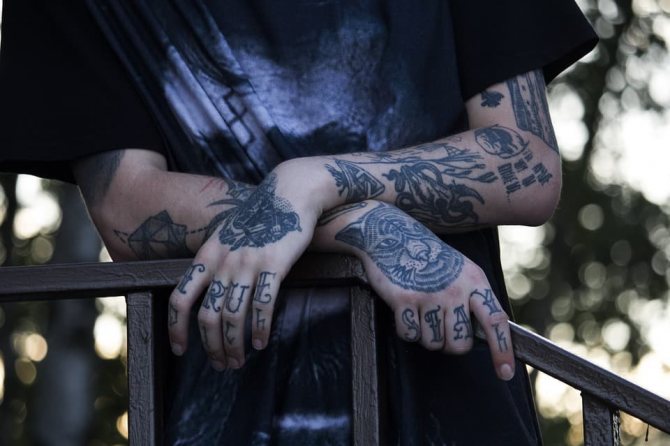
How to cover up a tattoo if you are a victim of a crooked master or just drastically changed your preferences? Learn 5 facts about how a cover-up is done.
Do you have a tattoo so bad that you wish you didn't have one at all? Unfortunately, this situation is not uncommon. But there is a way out of it, or rather, even two: to remove the tattoo with a laser or to cover it.
The first option is a radical solution that gives a complete removal of the image, but has a number of serious drawbacks. For example, the high cost - although one removal session may be cheaper than getting a tattoo, you have to do at least 5-8. Do the math for yourself...
The second disadvantage is the painful sensations. Removing a tattoo with a laser is much more than overkill it. Not even the use of anesthetic ointment and the fact that the procedure lasts 5-25 minutes is not saving. Even tough bearded men sometimes can't hold back tears.
If these disadvantages of laser removal seem too serious for you, and to get rid of the tattoo cardinally and completely you, in general, do not need, think about, How to remove a tattoo..
But first, you should study the list of reasons why people usually become "proud" owners of partaks. After all, the problem is better eradicated in its infancy, right?
What is a cover up and why is it needed


Cover up (cover up) is the overlapping of a tattoo with a new design. Specialists studios are often faced with cases where a client wants to remove an outdated or low-quality image. Let's look at the common reasons why people come for a tattoo overlapping session:
- Poor quality work by a beginner - not always novice tattoo specialists exhibit their own work on the Internet, victims of such "masters" have to turn to experienced and verified specialists for a cover-up.
- Unusual to a master stylistics of work - as a rule, masters of tattoo salons specialize on the concrete technique and stylistics of work, whether it is realism, minimalism, dotwork, watercolor or something else. Even if the master will agree to perform your sketch in a new technique for him, the result may disappoint you.
- Life circumstances - tattoos can be done at a certain stage of life, be associated with a particular person or event. When there are some changes, from the images of the past try to get rid of. A striking example is the names of former lovers.
- Loss of Tattoo Relevance - The tattoo industry, like any other, has the latest trends and fashions. Tastes can change over time, the fashion of birds and tribbles is a thing of the past. Also, due to physiological changes (skin laxity, weight fluctuations and the like), the design can change and lose its appeal.
- A tattoo that has lost its appearance - drawings require renewal and proper care. Burned out and discolored pigments made with substandard inks from past generations can be replaced with stylish new tattoos.
The procedure of covering up is more expensive than applying a tattoo on a clean piece of skin. This is caused by the complexity of creating a sketch - the master must take into account the size and colors of the old image.
What is a cover-up?
If you are tired of your tattoo or the tattoo was done wrong then you should know what a cover-up is! The word cover has its roots in the English language and literally means "to cover up". That is, cover up in the art of tattoos means to cover up one tattoo with another. Of course, it is very cool when there is a possibility to correct "partak", modify bothered tattoo or simply overlap figure for some reasons known only to the owner of the tattoo. In such cases, the cover up as never before.
- Yes, at the end you get a new, fresh, beautiful tattoo. But the process of this change has its own nuances. In front of the master who does the cover up is a difficult task. To make a sketch of a new tattoo for the client, taking into account the peculiarities of the existing image.
- In some cases explain to the client why this or that image is not suitable for overlapping the old tattoo.
- A professional tattoo artist knows that when applying light paint over the dark contours of an old tattoo, the dark color is bound to show up after a while. Even if at first it seems that the old pattern is not visible at all. Therefore it is very important to make a correct sketch.
It happens that the client first needs to resort to the removal of the tattoo in order to remove the necessary parts of the figure or lighten the tattoo.
Coverage up - the procedure is costly both in time and financially. But if there is no way to retreat, it is necessary to know some points to get, all the same, high-quality work in the end.
- Without the use of a laser (removal of the previous tattoo) cover up is made much darker in color and larger in size. In most such cases, the old tattoo is "painted over" with blackwork, realism, abstract tattoos, oldskool or newskool tattoos. A dark tattoo cannot be overlaid with light shades. In such cases, the background of the new tattoo is superimposed on the original image, and the main element of the tattoo is printed next to it. Covert up without preliminary lightening of the old tattoo foresees a dense shading.
- If there is a possibility and great desire, of course, it is better to go to the laser. The number of procedures will depend on the susceptibility of the skin and the image on it. With this kind of treatment the possibilities for a cover up are greatly increased.
- Sometimes it happens that seems like the tattoo is not bad, but for some reason it does not have the right look (whether the master got unprofessional, or care for the tattoo was inappropriate). Cases without a full overlap are very rare, but still occur. Then the master has a hard time - you need to consider the original sketch, to correct deficiencies, to select the shades and tones.
To the process of cover up it is necessary to approach responsibly, because you already have a low-quality tattoo. Therefore, to fix this, be prepared for a long period of creating a new body art and henceforth refer only to experienced tattoo masters to avoid another overlap.
Peculiarities of tattoo overlapping


Before you go to a tattoo master for a cover-up session, there are a few nuances to consider.
Not all styles of tattoo can be overlapped. If the old image has areas with solid coloring, it will not be possible to apply light watercolor drawings on top. In this case, it is necessary to first lighten the tattoo site with a laser machine. Sometimes you also need to remove excess parts of the old tattoo that do not overlap with the new design.
The easiest way to overlap the old design can be a tattoo, made in blackwork style - when the area of the body is applied in a dense black color. However, such a tattoo will not look good on every person and not every area.
In the process of transforming the image, the shapes and colors of the tattoo change, but it is worth taking into account that the result of the cover-up will be several shades darker than the old image.
When overlaying it is preferable to use cool shades of blue and green, as well as dense gray tones. Reds and yellows are not saturated enough, they will not be able to hide the old pigments completely.
Cover up tattoos - basic nuances.
If you decide to redo a tattoo, you must understand the basic nuances of this process. This is quite a complicated procedure, characterized by its meticulousness and the ability to choose the right design and color palette. Indeed, to fix the tattoo can only be a true master of his craft, who knows how to organically choose the size, shades and details of the overlapping picture. Here it is necessary to skillfully choose a suitable sketch, which will not only perfectly hide the old drawing, but also please the client. Examples of work on the correction of tattoos on the photo "before and after" you can find in our catalog.
Why, a person who consciously went to a master, suddenly decides to fix a tattoo? There are several fairly good reasons for this, for example:
- the tattoo was foolishly done in his teens, the army, for company;
- On a solid, business man, a tattoo of poor quality, a sign of bad taste, it is necessary to correspond to the status;
- Mothers of a noble family, a tattoo can look quite ridiculous after a while, and even more so if it "smells" of vulgarity or vulgarity;
- Most often, it happens that the tattoo was not made by a professional, and it was of low quality.
How does the overlay of a tattoo take place?


The process of preparing a sketch for a cover-up of an old image is time-consuming and difficult. An experienced and skillful master needs to arrange the new picture harmoniously on the old tattoo. It is not necessary to insist on certain drawings and elements - it happens that their application will not be able to overlap the old tattoo.
After careful tracing of all the details of the new image the master proceeds to the session. Be ready, probably one visit to the tattoo salon will not be enough.
Experts note that the overlapping of the tattoo is the easiest, inexpensive and comfortable way to get rid of the unsuccessful drawing on the body. In contrast to the painful and very long laser removal, as well as dubious folk recipes using iodine, salt, hydrogen peroxide and other methods.
Attempts to remove tattoos at home can lead to disastrous consequences and cause irreparable harm to health.
In conclusion, we should note that the decision to perform a tattoo should be considered, because the picture becomes a part of the person. However, if the mistakes of the past have left images on your body that have lost relevance, the masters of tattoo studios will help you get rid of them.
How to become a partaker: 3 options
- The recommendation not to drink before the session is for wimps. Are you pretty drunk and afraid you can't take responsibility for your decisions? Hmm, it's time to head to the tattoo parlor! After all, now you can do what you have so long hesitated to do. And to make yourself a portrait of the president in a hat with earflaps, or an inscription in a swear word - it's a very funny idea.
- Oh, how I want a tattoo...and that would be cheaper. What good fortune that my neighbor Vasya/Pasha/Andrey - a very novice master of tattoo. When your own person works - it's somehow more reliable than some salon out there? And his lack of experience is not so important.
- If I'm a fan, then I'm a fan! It's just impossible that I'm some 5-10 years to settle down, take out all your piercings and stop dyeing your hair green. So the writing "Aria" on your chest and the angel of death all over your back is a good idea for a tattoo.
P.S. We hope you understand that the situations simulated above are harmful advice? Categorically avoid them and pass this valuable knowledge to your friends.
Embedding pigment under the skin during tattooing
Our skin consists of several so called layers: epidermis (top layer), derma and subcutaneous fatty tissue. During tattooing the pigment is embedded in the dermis of the skin. What happens to it next? Like any other foreign body that enters our body, the protective cells of the connective tissue envelope the pigment and it begins to take root.
The healing process of the tattoo lasts about a month. And during this time, the body's protective barrier functions have already removed all the extra particles of pigment. There remained only the one that has taken root. And it turns out that once in the dermis, the pigment takes root there, stays and does not go anywhere.
How does a tattoo overlap happen?


After some time, the person wants to get another tattoo in the same place. The master again takes the pigment and injects it into the same layer of dermis. But the old pigment is already there, and it's not going anywhere. And so the new pigment is looking for a place for itself. It can settle over, between, or under the old pigment in the dermis layer. It depends on how different the size of the particles of the coloring element is.
And here the master cannot predict what will happen, how the old and new pigment will "behave". This is our physiology and we cannot influence it.
Consequences of poor quality canvassing
Immediately after a coverup, a new tattoo can look quite decent. Most often this is due to the fact that in the process of tattooing, some of the pigment gets not only into the dermis, where it will stay forever, but also into the upper layer of the skin - the epidermis. There is also red swelling. Therefore, it seems that the fresh pigment lies dense and looks beautiful. But we can evaluate the quality of the overlapping not earlier than in a month, after the complete healing. During this time the epidermis is completely renewed, the pigment is gone together with keratinized skin cells. In the skin will remain only pigment in the dermis. And only then you can see the real picture of the overlap.
And often after the complete healing there is something that masters don't put in their portfolio. This is something that is hidden from view. The old pigment can look like a kind of shadow, a "highlighting" for the new tattoo, like a bruise. This is at best. More often it looks like a mush: there is the old pigment with its own shade, and there is the new tattoo, which has its own rich color.
It is not uncommon for an old tattoo to simply visually "pop out" on top of a new one in exactly the same pristine form as it was before. Because the old pigment is not going anywhere.
It is very important that the client is aware that there are tattoos that cannot simply be overlaid with a new one.
